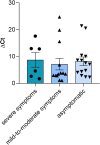TAS2R38 gene methylation is associated with syndrome Coronavirus 2 (SARS-CoV-2) infection and clinical symptoms
- PMID: 40280971
- PMCID: PMC12032294
- DOI: 10.1038/s41598-025-95879-x
TAS2R38 gene methylation is associated with syndrome Coronavirus 2 (SARS-CoV-2) infection and clinical symptoms
Abstract
TAS2R38 is the T2R receptor primarily associated with the innate immune response of the respiratory system. It activates a response mediated by nitric oxide (NO), which has been shown to inhibit the replication of SARS-CoV-2. TAS2R38 polymorphisms (SNPs) that decrease receptor functionality contributing to individual differences in susceptibility to airway infections. DNA methylation (DNAm) may affect gene expression influencing disease development, including COVID-19. We analyzed the effect of SARS-CoV-2 on the methylation pattern of TAS2R38 (at cg25481253, a CpG site located in the coding region) during infection and after the cessation of the exposure to the virus, also considering the disease severity and TAS2R38 SNPs. Our results showed a positive relationship between TAS2R38 DNAm levels and disease severity in the COVID-19 patients and a return to a normal state after the infection. In addition, our results showed an association between DNAm level and the TAS2R38 genotype in participants who recovered from the disease. PAV/PAV genotypes showed lower TAS2R38 DNAm levels than heterozygous and AVI homozygous. In conclusion, our results clearly indicate the involvement of TAS2R38 DNAm alteration in COVID-19 severity and suggest a role of the methylation changes at cg25481253 in the regulation of the TAS2R38 expression.
Keywords: TAS2R38 gene methylation; COVID-19; SNPs of TAS2R38 gene; TAS2R38 receptor.
© 2025. The Author(s).
Conflict of interest statement
Declarations. Competing interests: The authors declare no competing interests.
Figures




Similar articles
-
TAS2R38 Genotype Does Not Affect SARS-CoV-2 Infection in Primary Ciliary Dyskinesia.Int J Mol Sci. 2024 Aug 8;25(16):8635. doi: 10.3390/ijms25168635. Int J Mol Sci. 2024. PMID: 39201321 Free PMC article.
-
Primary Ciliary Dyskinesia: The Impact of Taste Receptor (TAS2R38) Gene Polymorphisms on Disease Outcome and Severity.Int Arch Allergy Immunol. 2020;181(9):727-731. doi: 10.1159/000508938. Epub 2020 Jul 13. Int Arch Allergy Immunol. 2020. PMID: 32659773
-
Distribution of TAS2R38 bitter taste receptor phenotype and haplotypes among COVID-19 patients.Sci Rep. 2022 May 5;12(1):7381. doi: 10.1038/s41598-022-10747-2. Sci Rep. 2022. PMID: 35513681 Free PMC article.
-
COVID-19 as a worldwide selective event and bitter taste receptor polymorphisms: An ecological correlational study.Int J Biol Macromol. 2021 Apr 30;177:204-210. doi: 10.1016/j.ijbiomac.2021.02.070. Epub 2021 Feb 11. Int J Biol Macromol. 2021. PMID: 33582215 Free PMC article.
-
Variants in ACE2; potential influences on virus infection and COVID-19 severity.Infect Genet Evol. 2021 Jun;90:104773. doi: 10.1016/j.meegid.2021.104773. Epub 2021 Feb 17. Infect Genet Evol. 2021. PMID: 33607284 Free PMC article. Review.
References
-
- Behrens, M. & Meyerhof, W. In sensory and metabolic control of energy balance. results and problems in cell differentiation Vol. 52 (ed Beisiegel U. Meyerhof W., Joost HG.) 87–99 Springer, (2011).
-
- Depoortere, I. Taste receptors of the Gut: emerging roles in health and disease. Gut63, 179–190. 10.1136/gutjnl-2013-305112 (2014). - PubMed
-
- Yamamoto, K. & Ishimaru, Y. Oral and extra-oral taste perception. Semin Cell. Dev. Biol.24, 240–246. 10.1016/j.semcdb.2012.08.005 (2013). - PubMed
MeSH terms
Substances
Grants and funding
- F73C22001230007/Fondazione di Sardegna - Convenzione triennale 2021-2023
- F25F21002720001/UniCA - Progetti di Ricerca Start-Up D.M. 737/2021
- F73C22001270007/Fondazione di Sardegna -Convenzione triennale 2022-2024
- F73C22001270007/Fondazione di Sardegna -Convenzione triennale 2022-2024
- F53C22000580001/POS Italian Health Ministry 2023
LinkOut - more resources
Full Text Sources
Medical
Miscellaneous

